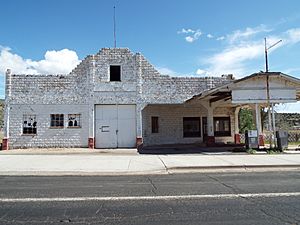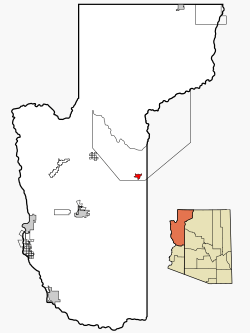Peach Springs, Arizona facts for kids
Quick facts for kids
Peach Springs, Arizona
Walapai: Hàkđugwi:v
|
||
|---|---|---|

John Osterman Shell gas station
|
||
|
||

Location in Mohave County and the state of Arizona
|
||
| Country | United States | |
| State | Arizona | |
| County | Mohave | |
| Area | ||
| • Total | 7.91 sq mi (20.50 km2) | |
| • Land | 7.91 sq mi (20.50 km2) | |
| • Water | 0.00 sq mi (0.00 km2) | |
| Elevation | 4,780 ft (1,457 m) | |
| Population
(2020)
|
||
| • Total | 1,098 | |
| • Density | 138.74/sq mi (53.57/km2) | |
| Time zone | UTC-7 (MST) | |
| • Summer (DST) | UTC−7 (no DST) | |
| ZIP code |
86434
|
|
| Area code(s) | 928 | |
| FIPS code | 04-53770 | |
| GNIS feature ID | 9278 | |
Peach Springs (which the Hualapai people call Hàkđugwi:v) is a small community in Mohave County, Arizona, United States. It's known as a census-designated place (CDP). In 2020, about 1,098 people lived there.
Peach Springs is very important to the Hualapai people. It serves as the main office and center for their tribal government. The community is located right on the Hualapai Reservation.
Contents
Exploring Peach Springs' Location
Peach Springs is found in the eastern part of Mohave County. It sits on both sides of Arizona State Route 66, which is part of the famous historic U.S. Route 66.
The town is about 50 miles (80 km) northeast of Kingman. It's also about 37 miles (60 km) northwest of Seligman.
The community covers an area of about 7.9 square miles (20.5 square kilometers). All of this area is land. Peach Springs is mostly on the north side of Yampai Canyon. Truxton Wash, a stream, flows west through this canyon.
Who Lives in Peach Springs?
Peach Springs has seen its population change over the years.
- In 1990, there were 787 people.
- In 2000, the population was 600.
- By 2010, it grew to 1,090 people.
- In 2020, the population was 1,098.
Most people living in Peach Springs are Native American. In 2000, about 93% of the residents were Native American. A smaller number of people were White or from other backgrounds. About 5% of the population identified as Hispanic or Latino.
Many households in Peach Springs have children. In 2000, nearly half of the homes had kids under 18 living there. The average household had about 3 to 4 people.
Fun Things to Do and See
Peach Springs is a gateway to some amazing natural sights.
Hualapai Lodge and Grand Canyon Adventures
The town has the Hualapai Lodge, which is a motel. There's also a small grocery store where you can get fuel. This lodge is a starting point for trips to Hualapai Hilltop.
Hualapai Hilltop is about 67 miles (108 km) northeast of Peach Springs. From there, hikers can walk an 8-mile (13 km) trail down into a canyon. This trail drops about 2,004 feet (611 meters). At the bottom, you reach the town of Supai. From Supai, you can visit beautiful places like Havasu Falls and other waterfalls.
Route 66 History
Peach Springs is located on the historic US Route 66. This famous road used to bring many travelers through the town. However, in 1978, a new highway called Interstate 40 (I-40) opened about 25 miles (40 km) south of Peach Springs.
I-40 changed things a lot for Peach Springs. It made the journey shorter between Kingman and Seligman. But it also meant that towns like Peach Springs were no longer on the main travel route. This caused economic challenges for the town. Even though it suffered, Peach Springs survived because it is the administrative center for the Hualapai tribe.
Historic Buildings
One interesting old building in Peach Springs is the John Osterman Shell Station. A Swedish immigrant built it in 1929. It closed around the year 2000. In 2007, the Hualapai Tribe received money to fix up the building. It was even added to the National Register of Historic Places in 2012.
Schools in the Area
Peach Springs has its own school district, called the Peach Springs Unified School District. It used to have a high school named Music Mountain Junior/Senior High School.
There is also a school called Valentine Elementary School. Even though it has a Peach Springs mailing address, the school building is actually in a nearby town called Truxton.
See also
 In Spanish: Peach Springs para niños
In Spanish: Peach Springs para niños




